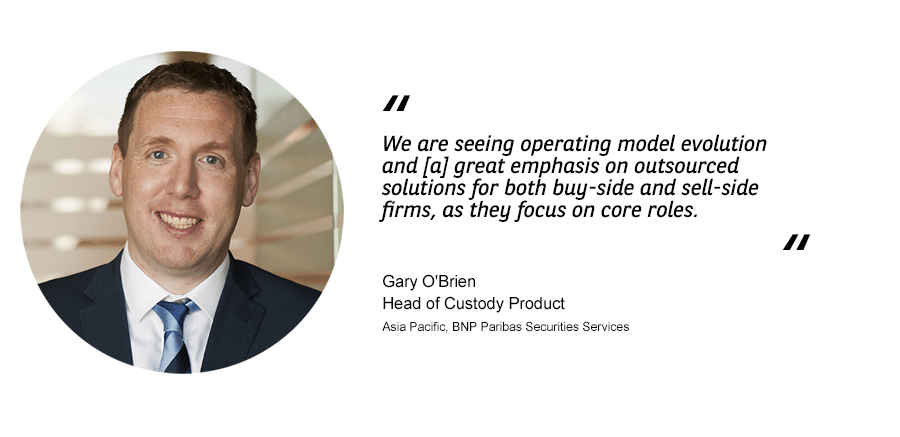This article was first published by Risk.net, under the title “Custodian of the year: BNP Paribas Securities Services”
BNP Paribas Securities Services is a relative newcomer to the Asia Pacific custody market, but the building blocks it put in place over the past 10 years has helped the firm sign up a slew of mandates in 2018, with the momentum continuing into this year.
Its victory, as the custodian of the year for 2019, stems from its capacity to act as a connector and develop solutions for asset managers, asset owners, banks and brokers, and at the same time win new business.
Over the past year, the firm has won mandates for companies based in Australia to China to Singapore to support global clients’ regional business. The type of clients span asset managers, financial institutions and sovereign wealth funds. The deals are a testament to its plans to extend its European roots into the region over the past decade and a strategy that helps it attract both regional and global clients.
“We are focusing on the global strategy and the regional strategy,” says Gary O’Brien, Head of Custody Product for Asia Pacific (APAC) at the firm. “In APAC, we have got eight locations and 11 offices, but they are overseen from a regional perspective by the regionally empowered management team. They are responsible for ensuring the effective management within the region, to ensure the same thing isn’t being developed twice in two different locations in different ways.”
The services for which it is winning mandates include traditional areas of work, such as custody, investment administration and performance reporting, but also innovative new lines such as data-as-a-service, which help it to support firms as they evolve into more digital ways of working, and clients with more quantitative approaches to investment.
“We are seeing operating model evolution and Market structural changes in APAC, from the development of the Stock Connect and Bond Connect links between the Hong Kong and mainland China markets, to the evolution of Australia’s post-trade infrastructure towards a distributed ledger model, all demand that investment firms have a firm grip upon the post-trade and asset-servicing aspects of their business.

Custodians need to bridge these gaps in each jurisdiction for their clients, by managing the change process and any technology implications, he says.
“You try to have a good governance structure, clear milestones and targets,” says O’Brien. “It becomes more difficult to do that when a new project is not being controlled directly by the organisation itself. An example like that is the project to remain fully integrated, with the Australian Stock Exchange replacing its infrastructure with blockchain technology.”
That required interacting with a new technology that’s being rolled out for the first time at the post-trade and market-infrastructure level, he says.
The bank puts its capacity to handle process and development down to the structural changes that began 24 months ago within securities services. The firm moved from what had historically been a product-line structure to a client-line structure.
“From that perspective, we organised ourselves globally into four client lines and from a client solution development perspective: asset owner; asset manager; alternative client; and our financial intermediaries and corporates client line,” says O’Brien.
As a result, the parties responsible for products and solutions that the bank develops and delivers to clients have been looking at things from a much more holistic perspective for that particular set of clients, he argues.
This has allowed BNP Paribas Securities Services to maintain a strong product and service development line for clients needing customised products, as well as more standardised services, while managing the costs of doing so.
“Within securities services it’s a constant debate between tailored solutions versus more standardisation, be it messaging or to the types of solutions that you are providing,” O’Brien observes. “Different parties are at different stages of that journey, so it’s not a one-size-fits-all situation, [but] you can’t be an organisation that is all things for all parties. You have to be selective on the firms that you will work with – and essentially partner with – to develop tailored solutions.”
These plans have had the backing of its key clients.
One government agency says: “Our decision to use BNP Paribas was based on their institutional capabilities and team’s competence, market-leading solutions and systems, adaptability to our needs and service excellence.”
A major asset owner said of the bank’s outsourcing capabilities: “The transition process went as planned, and service delivery since then has met our expectations … BNP Paribas Securities Services has worked closely with our operations, IT, client services and product teams on any new requirements, including new product requirements. We see BNP Paribas as a dependable vendor.”
BNP Paribas Securities Services is a relative newcomer to the Asia Pacific custody market, but the building blocks it put in place over the past 10 years has helped the firm sign up a slew of mandates in 2018, with the momentum continuing into this year.
Its victory, as the custodian of the year for 2019, stems from its capacity to act as a connector and develop solutions for asset managers, asset owners, banks and brokers, and at the same time win new business.
Over the past year, the firm has won mandates for companies based in Australia to China to Singapore to support global clients’ regional business. The type of clients span asset managers, financial institutions and sovereign wealth funds. The deals are a testament to its plans to extend its European roots into the region over the past decade and a strategy that helps it attract both regional and global clients.
“We are focusing on the global strategy and the regional strategy,” says Gary O’Brien, Head of Custody Product for Asia Pacific (APAC) at the firm. “In APAC, we have got eight locations and 11 offices, but they are overseen from a regional perspective by the regionally empowered management team. They are responsible for ensuring the effective management within the region, to ensure the same thing isn’t being developed twice in two different locations in different ways.”
The services for which it is winning mandates include traditional areas of work, such as custody, investment administration and performance reporting, but also innovative new lines such as data-as-a-service, which help it to support firms as they evolve into more digital ways of working, and clients with more quantitative approaches to investment.
“We are seeing operating model evolution and Market structural changes in APAC, from the development of the Stock Connect and Bond Connect links between the Hong Kong and mainland China markets, to the evolution of Australia’s post-trade infrastructure towards a distributed ledger model, all demand that investment firms have a firm grip upon the post-trade and asset-servicing aspects of their business.

Custodians need to bridge these gaps in each jurisdiction for their clients, by managing the change process and any technology implications, he says.
“You try to have a good governance structure, clear milestones and targets,” says O’Brien. “It becomes more difficult to do that when a new project is not being controlled directly by the organisation itself. An example like that is the project to remain fully integrated, with the Australian Stock Exchange replacing its infrastructure with blockchain technology.”
That required interacting with a new technology that’s being rolled out for the first time at the post-trade and market-infrastructure level, he says.
The bank puts its capacity to handle process and development down to the structural changes that began 24 months ago within securities services. The firm moved from what had historically been a product-line structure to a client-line structure.
“From that perspective, we organised ourselves globally into four client lines and from a client solution development perspective: asset owner; asset manager; alternative client; and our financial intermediaries and corporates client line,” says O’Brien.
As a result, the parties responsible for products and solutions that the bank develops and delivers to clients have been looking at things from a much more holistic perspective for that particular set of clients, he argues.
This has allowed BNP Paribas Securities Services to maintain a strong product and service development line for clients needing customised products, as well as more standardised services, while managing the costs of doing so.
“Within securities services it’s a constant debate between tailored solutions versus more standardisation, be it messaging or to the types of solutions that you are providing,” O’Brien observes. “Different parties are at different stages of that journey, so it’s not a one-size-fits-all situation, [but] you can’t be an organisation that is all things for all parties. You have to be selective on the firms that you will work with – and essentially partner with – to develop tailored solutions.”
These plans have had the backing of its key clients.
One government agency says: “Our decision to use BNP Paribas was based on their institutional capabilities and team’s competence, market-leading solutions and systems, adaptability to our needs and service excellence.”
A major asset owner said of the bank’s outsourcing capabilities: “The transition process went as planned, and service delivery since then has met our expectations … BNP Paribas Securities Services has worked closely with our operations, IT, client services and product teams on any new requirements, including new product requirements. We see BNP Paribas as a dependable vendor.”
